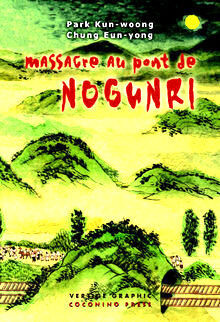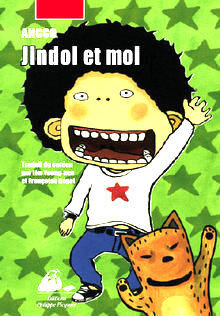hankyoreh
Links to other country sites 다른 나라 사이트 링크
Korean comic books win over European fans

South Korean comic books by leading artists are steadily gaining popularity in European comic book markets. Until now, Japanese comic books have been the most popular with Europeans, but creations by artists such as horror specialist Hyeong Min-u’s ‘‘Priest,’’ Lee So-yeong’s ‘‘Model,’’ a mix between a Western vampire story and a pure love story, Kang Full’s ‘‘Apartment,’’ which pioneered Korean Internet comics and Park Kun-woong’s ‘‘Massacre at Nogunri,’’ which depicts the U.S. Army-led civilian massacre during the Korean War, are winning fans because they are not as obscene or violent,

while still managing to be just as sophisticated and interesting as their Japanese counterparts.
South Korean comic books started to advance into European markets in as late as 2002, but exports have rapidly increased. Daiwon Culture Industry Inc. (Daiwon CI), the nation’s biggest comic book publisher, began to export its products to Europe in 2002 and the export amount has significantly increased every year, to 370 million won (US$400,000) in 2004 and 620 million won (US$668,000) in 2006. According to the industry, other important comic book publishing houses, including Haksan Pub Co., have also increased exports to Europe.
Overseas export markets have been expanded to a number of countries, such as Germany, Italy, Spain and Russia, from France, where comic strips and longer graphic novels are being translated and published at a growing rate.
Casterman, one of the largest comic book publishers in France, published Park Kun-woong’s ‘‘Flower’’ and ‘‘Massacre at Nogunri’’ last year, while this year, French company Picquier published ‘‘Ancco’s Picture Diary’’ (‘‘Jindol et Moi’’ in French), written by Choi Gyeong-jin, who goes by the pen name Ancco.
Because they are just as attractive, from a commercial perspective, as the most popular Japanese comics, an industry expert said. Korean comics have also gained a reputation in Europe for showcasing the artist’s unique aesthetic, said the expert. In addition, domestic writers begun to diversify their marketing strategies by holding book signings for local comic book fans, he said.
Europe occupies up to 40 percent of the overall export market for South Korean comic books, the industry estimates, becoming the biggest market, followed by the U.S. and Asia with 30 percent each. ‘‘If the nation’s comic books can enter European markets, they will easily be able to advance into other markets, like those in Latin America, thanks to language advantage. Therefore, we are concentrating our efforts on strategically expanding exports to Europe,’’ said Oh Tae-yeop of Daiwon CI. The Korea Content Information System’s (KOCCA) data shows that Korea’s comic book export total amounted to about 3 billion won (US$3.26 million) in 2005.
The experts, however, noted that Korea’s comic book industry still has a long way to go. Above all, Korean comics haven’t yet inspired the kind of mania displayed by fans of Japanese comics. According to the experts, Korea should work in concert with other genres, like animation, in order to support wider distribution of Korean comic books.
Please direct questions or comments to [englishhani@hani.co.kr]
Editorial・opinion
![[Column] Park Geun-hye déjà vu in Yoon Suk-yeol [Column] Park Geun-hye déjà vu in Yoon Suk-yeol](https://flexible.img.hani.co.kr/flexible/normal/500/300/imgdb/original/2024/0424/651713945113788.jpg) [Column] Park Geun-hye déjà vu in Yoon Suk-yeol
[Column] Park Geun-hye déjà vu in Yoon Suk-yeol![[Editorial] New weight of N. Korea’s nuclear threats makes dialogue all the more urgent [Editorial] New weight of N. Korea’s nuclear threats makes dialogue all the more urgent](https://flexible.img.hani.co.kr/flexible/normal/500/300/imgdb/original/2024/0424/7317139454662664.jpg) [Editorial] New weight of N. Korea’s nuclear threats makes dialogue all the more urgent
[Editorial] New weight of N. Korea’s nuclear threats makes dialogue all the more urgent- [Guest essay] The real reason Korea’s new right wants to dub Rhee a founding father
- [Column] ‘Choson’: Is it time we start referring to N. Korea in its own terms?
- [Editorial] Japan’s rewriting of history with Korea has gone too far
- [Column] The president’s questionable capacity for dialogue
- [Column] Are chaebol firms just pizza pies for families to divvy up as they please?
- [Column] Has Korea, too, crossed the Rubicon on China?
- [Correspondent’s column] In Japan’s alliance with US, echoes of its past alliances with UK
- [Editorial] Does Yoon think the Korean public is wrong?
Most viewed articles
- 1‘We must say no’: Seoul defense chief on Korean, USFK involvement in hypothetical Taiwan crisis
- 2N. Korean delegation’s trip to Iran shows how Pyongyang is leveraging ties with Moscow
- 3‘Weddingflation’ breaks the bank for Korean couples-to-be
- 4[Reportage] On US campuses, student risk arrest as they call for divestment from Israel
- 5Amnesty notes ‘erosion’ of freedom of expression in Korea in annual human rights report
- 6[Column] Park Geun-hye déjà vu in Yoon Suk-yeol
- 7Korea sees more deaths than births for 52nd consecutive month in February
- 8[Editorial] New weight of N. Korea’s nuclear threats makes dialogue all the more urgent
- 9Will NewJeans end up collateral damage in internal feud at K-pop juggernaut Hybe?
- 10[Guest essay] The real reason Korea’s new right wants to dub Rhee a founding father